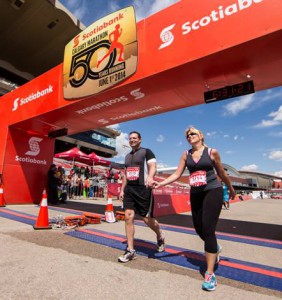 Wow! You made it to the finish. You feel elated and exhausted at the same time. As you may not be thinking as clearly as usual, having a post race agenda prepared in advance will help set you up for optimum recovery.
Wow! You made it to the finish. You feel elated and exhausted at the same time. As you may not be thinking as clearly as usual, having a post race agenda prepared in advance will help set you up for optimum recovery.
The First Hour
After crossing the line and receiving your medal there are a few key things to do.
1. Nutrition will be located in the food tent at the end of the chute channeling you away from the finish line. Pick up post race goodies such as fruit, water and energy drinks. Try to consume something within this first hour as it is an optimum opportunity for the body to start refueling. If you have a favorite recovery drink or smoothie put it in your race bag for pick up after the race.
2. Unless race day is hot you will chill quickly from the sweat and spilled water/energy drink on your body and race gear. As soon as you can, remove wet clothes and change into something warm, soft and familiar. A change of shoes is also a good idea.
3. If you have bad blisters, have injured something during the run, or just plain feel poorly go to the medical tent. There are doctors, nurses, paramedics and physiotherapists there to treat and advise you. This will be located near the finish line.
4. Keep moving. A proper cool down of ten to twenty minutes of walking and gentle stretching can make the rest of the day more enjoyable.
The First Day
Make the most of the first 24 hours.
1. Post race massage can help start the recovery process. This type of massage utilizes techniques for improving circulation and getting muscles to relax. It should not be too deep or hurt. This will be available race day on-site and should be purchased in advance.
2. Having a shower will help warm you up and rejuvenate you. If you are brave, a ten minute cold soak will help minimize post race muscle and joint stiffness.
3. Plan on having a proper meal sooner than later. Your stomach may not tolerate anything too complex. Try to get protein and carbohydrates in real food form, not just energy bars and drinks.
4. Elevating the legs for twenty minutes can help with circulation and minimize swelling in the ankles and feet. Getting the legs above the heart is the key, not just up on the couch.
5. More gentle stretching in the evening, especially hamstrings, calf, quads and buttock will help keep you from getting too stiff.
6. You might fall asleep quickly but may not sleep well the first night. As the body inflames from the workout and metabolism speeds up, deep sleep can be impaired. Doing the above noted activities may help with better sleep.
The Next Week
Other than feeling stiff and sore all over, you may also feel mental burnout.
1. Light exercise in the form of active recovery is the best prescription. Walking, easy cycling or swimming are good activities. This will get the blood flowing to the recovering muscles delivering nutrition and removing waste products. Your body will feel better and so will your mind.
2. Stretching and yoga can help restore the tight muscles back to normal length. Not stretching at all will make your body more injury prone when you resume training. Self massage techniques using foam rollers or trigger point tools will help loosen the tight muscles and restore mobility.
3. Keep eating well and getting enough sleep.
The Future
Taking at least a ten day to two week break from running will aid recovery and prevent injury in the future. When you do return to running, keep it short and easy. If you trained and raced hard it may take six weeks or more to be properly recovered and able to train for the next racing challenge!
(Originally published in the Calgary Marathon Race Guide 2010)